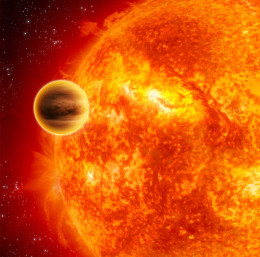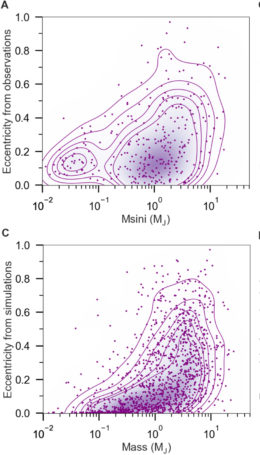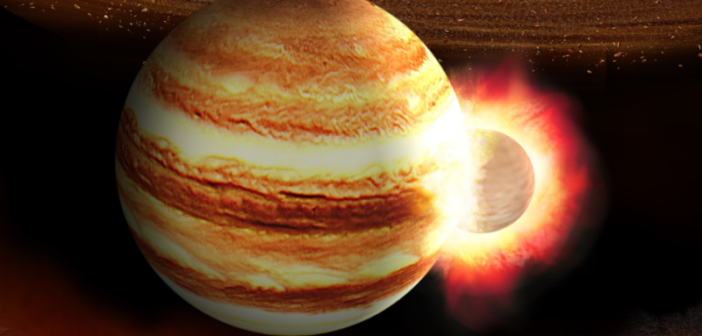How do you get close-in, giant planets on eccentric orbits? A new study suggests that a violent phase of planet-smashing might be a key part of the process.
High-Mass Lurkers

Artist’s impression of a close-in, giant exoplanet transiting across the face of its host star. [NASA/ESA/C. Carreau]
We’ve discovered quite a few gas giants that have orbital distances of less than 5 AU from their host stars, and the orbits of these planets are often eccentric — making them very unlike the well-behaved, nearly circular orbits of the planets in our solar system.
What causes the eccentricities of these giants? Numerous mechanisms have been proposed, from complex gravitational interactions between the inner giant planets and outer companions, to resonant interactions with a gas disk early in the stellar system’s formation.
But in a recent study led by Renata Frelikh (UCO/Lick Observatory, UC Santa Cruz), a team of scientists has explored a more dramatic scenario: what if eccentric, close-in giant planets are the result of a period of giant impacts?

Artist’s concept of two bodies colliding during the early stages of planet formation. [NASA/JPL-Caltech]
Coming Together Through Collisions
One of the leading theories for the formation of our own solar system predicts that, at the end of the assembly period for the inner solar system, our system underwent a giant-impact phase. During this time, hot young planetesimals smashed into one another — in fact, one of these collisions is blamed for throwing off material from Earth to later form the Moon.
Frelikh and collaborators propose that when planetary systems hosting multiple hydrogen-rich planets in their inner regions undergo a similar giant-impact phase, collisions can cause these planets to grow in mass as they merge. The collisions and scatterings eventually produce large, gaseous planets on close-in, eccentric orbits.
To test their theory, the authors conduct a series of N-body simulations tracking the collisions and mergers of planets in the inner regions of a modeled planetary system. They then compare their results to the properties of an observed sample of exoplanets orbiting F, G, and K stars.
More Mass, More Giants

Plots of eccentricity vs. mass as an example comparison of the distributions for observed planets (top panel) vs. authors’ simulated data (bottom panel). [Adapted from Frelikh et al. 2019]
They demonstrate that planet–planet collisions and scattering in their simulations leads to a distribution of eccentricities, orbit sizes, and planet masses at the end of the giant-impact phase that are consistent with the sample of planets we’ve observed.
The predictions made by the authors’ models can be tested further as we build a larger sample of observed exoplanets both in stellar systems’ inner and outer regions. But for now, this provides new insight into the potentially violent pasts of some of the unusual planets we’ve discovered.
Citation
“Signatures of a Planet–Planet Impacts Phase in Exoplanetary Systems Hosting Giant Planets,” Renata Frelikh et al 2019 ApJL 884 L47. doi:10.3847/2041-8213/ab4a7b
